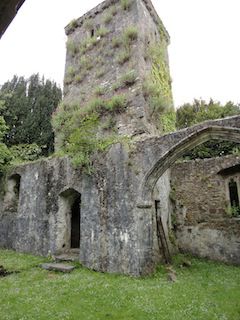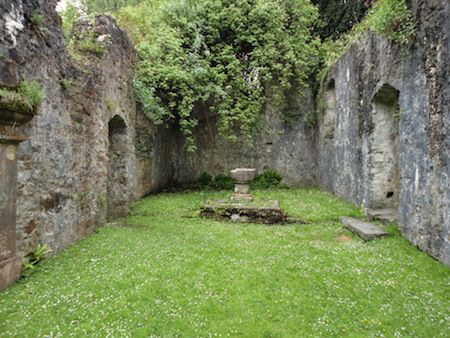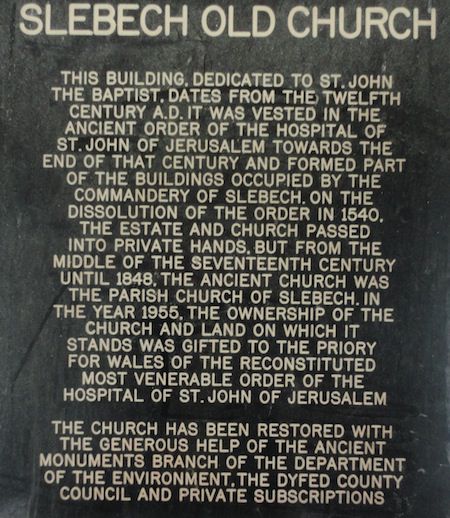Knights Hospitaller of St John of Jerusalem
15th January 2016

Church of St. John tower
Courtesy of Slebech Park
Some years ago, about fifteen I think, I attended, on one beautiful June evening, a rather special service in the ruined church of St John in the grounds of Slebech Park. The service was held on St John’s day of the 24th of June but was one that recognised the importance of the Knights Hospitaller on that site for hundreds of years.
At one point, a gentleman wearing a long black cloak and holding a long sword in front of him, came into the ruins and stood by the side of the vicar taking the service. It was an almost surreal experience; a congregation of a dozen or so, sat on chairs brought in for the event in the midst of a roofless, beautiful ruin.
It was suggested to me that the service would be a regular event but as far as I am able to ascertain there hasn’t been one since and as the estate, now a hotel and restaurant, has changed hands it is difficult to get any further information. However, it being June (well it was whilst I was writing this), I’ll tell you something about the Knights Hospitaller and their connection with Pembrokeshire.

Inside of the ruined Church of St John
Although the Order had to wait until 1139 for papal recognition, the Hospitallers were already by then a well recognised, famous and hugely respected Order as a result of their selfless and charitable work in nursing the wounded and succouring the dying during the 1st Crusade (1096-1099). It had also by then moved from being a charitable nursing Order to one that was extremely militaristic in duties and aspirations with an adopted motto/battle cry of, ‘Dieu le veut’ (God wills it).
Not long after the Flemings took up residence in Pembrokeshire in the very early 12th century, one of their leaders, Wizo the Fleming, who had his homestead and castle in Wiston, is regarded as having founded the Knights Hospitaller’s ‘hospitium’ at Slebech.
Rev Morris in his hugely informative and entertaining post war publication, ‘The Slebech Story’, goes into some of the detail that shows Wizo as having additionally been extremely generous in granting large amounts of Pembrokeshire land, along with the churches and mills etc that stood on that land, to a monastery in Gloucester (St Peter’s).
His son Walter however, considered these gifts to have been far too generous and took them back. There followed a decades long argument of almost unfathomable complexity, (to some extent because the monastery in Gloucester had already given the Pembrokeshire land to a Priory in Worcester), involving the King of England, (Henry I), the Bishops of St Davids and Exeter and finally the Pope.
The final solution was to give the land to the Knights Hospitaller (provided they in turn gave the Priory in Worcester £7 per annum) and from that point their land holdings in Pembrokeshire and importance rose to the extent that Slebech was the most important Hospitaller Commandery outside London. The fact that the Hospitallers considered Pembrokeshire as an essential site demonstrates the standing of St Davids as a preeminent place of pilgrimage for hundreds of years.
A long path known as The Knight’s Way goes from Slebech Park to Blackpool Mill, on through Canaston Wood, to Templeton and further. This was a thoroughfare for the Knights Hospitaller and drips with history all of the way. When the Knights Templar were suppressed (as a result of being too powerful) in 1308 their enormous assets were largely transferred to the Hospitallers.
As a result of the Reformation, the Order suffered at the same time as the dissolution of the monasteries in the late 1530s and the land was sold to swell the coffers of Henry VIII. The brothers of the corrupt Bishop of St Davids, Bishop Barlow, purchased the land and so began the Barlow dynasty.
The Hospitaller Commandery was destroyed and in time a mansion was built on the site. The church continued to be the parish church until the mid 19th century when the roof was taken off by Baron de Rutzen and the ‘new’ Slebech church was built on the side of the A40.
In 1758 Catherine Barlow married Sir William Hamilton, ambassador to Naples (who married Emma as his second wife), and when she died in 1782, her body was brought back and buried in this church. Sir William expressed a desire to be buried beside her although I’m unsure if that happened.

Memorial plaque
Courtesy of Slebech Park